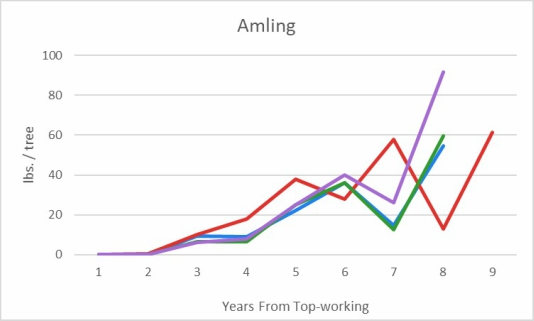Amling

Table 1. Quality of ‘Amling’ over eight years (2008-2015) after top-working.
| Cultivar | # Nuts/lb. | % Kernel | Cluster Size | 50% shuck split |
| Amling | 63 | 55% | 2.6 | Oct. 6 |
| Desirable | 46 | 51% | 2.3 | Oct. 10 |
| Stuart | 48 | 46% | 2.6 | Oct. 9 |
Figure 1. Individual tree yield of ‘Amling’ after top-working six year old trees. Each line indicates the yield of a separate tree.

Table 2. Average pest resistance of test cultivars in a sprayed orchard 2002-2016.
| Cultivar | Leaf ScabZ | Nut ScabY | Nut Scabx | Black Aphid Damagew |
| Avg. | Avg. | Worst | Avg. | |
| Amling | 1.0 | 1.0 | 1.0 | 1.0 |
| Desirable | 2.8 | 3.4 | 4.5 | 1.5 |
| Stuart | 1.1 | 1.1 | 2.8 | 2.5 |
- z1 = no scab lesions, 2 = a few isolated lesions with restricted growth, 3 = multiple lesions with expanding growth, 4 = stem scab lesions or defoliation.
- y1 = no scab lesions, 2 = a few lesions with restricted growth, 3 = multiple lesions, 0% to 10% coverage, 4 = 11% to 50% coverage, 5 = 51% to 100% coverage or nut drop. Average damage seen on nuts over the tree.
- x1 = no scab lesions, 2 = a few lesions with restricted growth, 3 = multiple lesions, 0% to 10% coverage, 4 = 11% to 50% coverage, 5 = 51% to 100% coverage or nut drop. Maximum damage seen on any nut.
- w1 = no damage, 2 = light chlorotic spotting, 0% to 25% leaves affected, 3 = moderate chlorotic spotting, 26% to 75% chlorotic spotting, 4 = heavy chlorotic spotting, 76% to 100% leaves affected.
History
Texas seedling selected for good resistance to pests.
Comments
We top-worked several trees to this selection in 2008. We followed yield in these trees for several years, but have now discontinued taking yield data. The history of this cultivar suggested it would have excellent resistance, but yields would be too low to be commercially viable. I believe now this may be the case. It took ‘Amling’ a pretty long time to come into production after top-working. After it began bearing, ‘Amling’ pretty quickly began an up and down production cycle (Fig. 1). In general, I don’t think ‘Amling’ produces enough nuts to make up for its small size to be commercially viable.
Nut size of ‘Amling’ is small (Table 1), averaging only 63 nuts / lb. Nut size was also variable, ranging anywhere from fairly large at 54 nuts / lb to very small at 73 nuts / lb. Kernel quality was usually very good, and it averaged 55% kernel. This is a very good shell out for this small of a nut. The shell of ‘Amling’ is thin, and the kernels shell out nicely. The kernel is long and oily, almost like a little ‘Schley’ in appearance. Kernel color is only average, and can darken fairly readily in storage.
The real beauty of the ‘Amling’ cultivar is its pest resistance (Table 2). We never see an issue with this cultivar. I have not observed scab on this cultivar in our sprayed trials or in our unsprayed trials. There are reports of scab at other locations in low-input trials, so it is not completely immune, but it is one of the best. In addition, I very rarely see any insect damage on this cultivar. This selection has beautiful dark green leaves normally free of any blemishes.
'Amling' is a type I (protandrous) cultivar. It would be pollinated by 'Cherryle', 'Zinner', 'Excel', 'Stuart', and 'Sumner'. It should also be a good pollinizer for 'McMillan' and 'Elliott'.
This is my favorite cultivar for a yard tree as the nuts are high quality, although small, and I have not seen any pest problems with this cultivar. I would also recommend it for organic or low-input applications as a pollinizer. ‘Amling’ is a type I tree, and we have very few type I scab resistant cultivars. Generally you are down to ‘Amling’, ‘Gafford’, and maybe ‘Creek’ if you want a type I scab-resistant pollinizer. For this reason, I often recommend ‘Amling’ as a pollinizer for 'Elliott' or 'McMillan'.
More information is available on 'Amling' from the Alabama Pecan Growers website.


